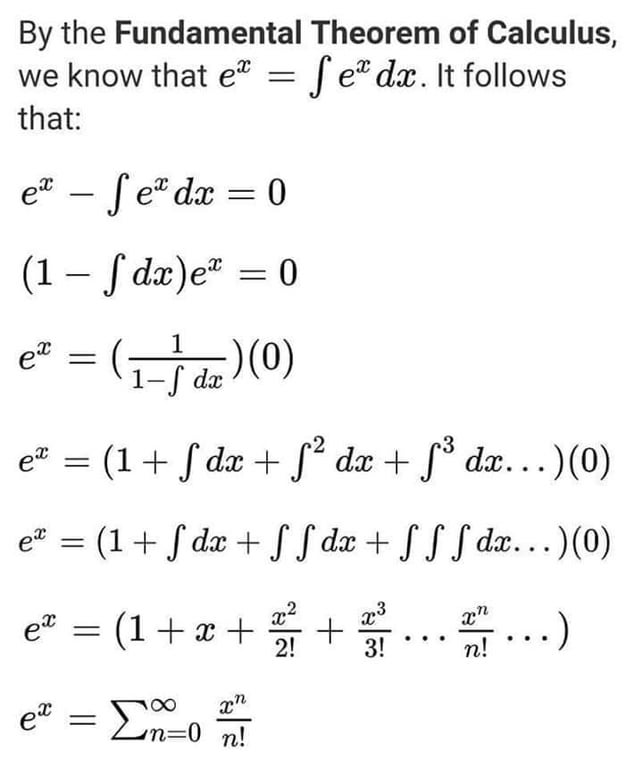If anyone’s curious, the first step is wrong. e^x minus its integral is a constant. Not necessarily zero.
Math Memes
Memes related to mathematics.
Rules:
1: Memes must be related to mathematics in some way.
2: No bigotry of any kind.
In step two you can't gake out e^x from the integral because is being integrated by the x variable.
behold! you have found ze joke
My math degree is only a handful of years old but I don't do math anymore so I have no clue how horrified I should be
Congrats on finishing your degree
As far as I can tell, every step but the last one is wrong.
Yeah I don't remember if the result is correct, but the process is definitely sus.
the result is correct
I don't believe you can just factor our e^x in the second step like that. That seems in incorrect to me. Then again I've been out of calculus for years now.
The process is horribly wrong, but the answer is correct. I think that's the intended joke.
Why'd the (0) vanish? Everything else seems "justified".
If we already regularly ignore infinities in the self-energy of electrons and other divergent stuff what's a little division by zero here or there?
Except the first assumption that e^x = its own integral, everything else actually makes sense (except the DX are in the wrong powers). You simply treat the "1" and "integral dx" as operators, formally functions from R^R into R^R and "(0)" as calculating the value of the operator on a constant-valued function 0. EDIT: the step 1/(1-integral) = the limit of a certain series is slightly dubious, but I believe it can be formally proven as well. EDIT 2: I was proven wrong, read the comments
That's the thing about physicists doing math. They know the universe already works. So if they break some math on the way to an explanation, so what? You can fix math. They care about the universe. It's pretty cool sometimes. Like bra-ket notation is really an expression the linear algebra concepts of dual space and adjoints. But to a physicist, it's just how the math should work if it is to do anything useful.
So yeah, this post looks like nonsense. Because it is. But there is a lesson that "math" should work like this, and there is utility in pushing the limits. No pun intended.
Edit: I'm not claiming this is a useful application. It's circular reasoning as this post's parent alludes to.
is it immediately obvious that the inverse of the operator L is 1/L though? Much less the series expansion for the operator...
If you try to fill in the technical details it will be a lot of work compared to a simpler calculus based alternative
But then again some Mathematicians spent the better half of the century formalizing the mathematics used by Physicists like Dirac (spoiler: they all turned out to be valid)
After careful consideration I have come to the conclusion that the inverse of the operator L is obviously not 1/L and you are absolutely right. This derivation is complete nonsense, my apologies. In fact no such inverse can even exist for the operator 1 - integral, as this function is not an injection.
What is meant here, I believe, is (1 - Int)^-1. Writing 1/(1 - Int) is an abuse of notation, especially when the numerator isn't just 1 but another operator, which loses the distinction between a left and a right inverse. But for a bounded linear operator on a normed vector space, and I think Int over an appropriately chosen space of functions qualifies, (1 - Int)^-1 equals the Neumann series \sum_k=0^∞ Int^k, exactly as in the derivation.
Int is injective: Take Int f = Int g, apply the derivative, and the fundamental theorem gives you f = g. I think you can make it bijective by working with equivalence classes of functions that differ only by a constant.
Int is definitely not injective when you consider noncontinuous functions (such as f(X)={1 iff X=0, else 0}). If you consider only continuous functions, then unfortunately 1-Int is also not injective. Consider for example e^x and 2e^x. Unfortunately your idea with equivalence classes also fails, as for L = 1 - Int, L(f) = L(g) implies only that L(f-g) = 0, so for f(X)=X and g(X)=X + e^x L(f) = L(g)
Sets of measure zero are unfair. But you're right, the second line in the image is basically an eigenvector equation for Int and eigenvalue 1, where the whole point is that there is a subspace that is mapped to zero by the operator.
I'm still curious if one could make this work. This looks similar to problems encountered in perturbation theory, when you look for eigenvectors of an operator related to one where you have the spectrum.
